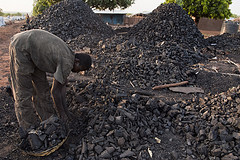Access to non-solid fuel

The lack of access to non-solid fuels for use in lighting, cooking, and heating is a worldwide issue that the World Health Organization estimates contributes to 4 million deaths per year.[2] The use of inefficient and harmful fuels in underdeveloped countries is a significant health, safety, and environmental issue. These non-solid fuels include liquid fuels such as kerosene, ethanol, or other biofuels as well as gaseous fuels such as natural gas. In contrast, solid fuels include traditional biomass such as wood, charcoal, and agricultural residues along with processed biomass such as briquettes.[2]
Health Risks
The incomplete combustion of fuels such as charcoal and other solid fuels results in harmful and polluting smoke that poses a significant heath risk.[2] Using these fuels increases chances of death from pneumonia, stroke, heart disease, chronic obstructive pulmonary disease (COPD), lung cancer, and other ailments.[3]
One main issue when burning solid fuels is the particulate matter that results in indoor air pollution. Along with these particles, such as black carbon, harmful smoke that includes carcinogens and carbon monoxide is realeased with the burning of solid fuels.[4] Inhaling these particles can result in respiratory infections, particularly in young children. As well, the presence of indoor smoke results in higher levels of COPD, particularly in women who are exposed to high levels of this smoke. These women are twice as likely to suffer from COPD than women who can cook with cleaner fuels.[3] As well, lung and throat cancers are more likely due to the frequent exposure to this smoke and particulate matter.
In addition to respiratory issues that arise due to polluting smoke that is created when these inefficient fuels are burned, the use of these fuels in the home also poses significant safety risks. The risk of burns due to unsafe cooking fuels and technologies poses a major health risk to women in developing countries.[4]
Other Negative Side Effects
In addition to the numerous health effects, time taken to gather fuels takes time away from children and limits time for income generation or schooling. As well, in more dangerous areas women and children are at risk of violence or injury while they are obtaining this fuel.[3] As well, improper storage of these fuels is a major cause of child poisonings worldwide that leads to death and nervous system damage.[4]
Trends
Currently, more than two-thirds of the rural population in the world depends on solid fuels for cooking and heating, with people in Sub-Saharan Africa, Oceania, and Southern Asia having the least access. These areas contain approximately 96% of all people without access to non-solid fuels.[2] In 2010, it was estimated that 2.8 billion people did not have access to clean burning cooking fuels.[4]
Generally speaking, access rates are worse in rural areas. Of all the people who are without reliable access to clean burning fuels, approximately 78% of those people live in rural areas.[4] As well, the access to non-solid cooking fuels is worse in the developing world, where the rate of access to clean burning fuels ranges from 19-95%.[2] More urbanized, higher income areas generally rely more on non-solid fuel, the prime example being Western Asia as it is the wealthiest and most urbanized area in the developing region. Western Asia, in stark contrast to the lack of non-solid fuel access in other areas in Asia, has almost universal access to non-solid fuels.[4] Although Sub-Saharan Africa and numerous places in Asia are still obtaining access to non-solid fuels, Eastern Europe and Western Asia have accomplished near-universal access. Recently, the growth rate of access to non-solid fuels was much larger than the growth rate in rural areas, with rates of 1.7% versus 0.6%.[2] This is likely due to the fact that less transportation is necessary to get a large amount of alternative fuels to urban centers than to distribute them in rural areas.
Without changes being actively made, the total number of people relying on solid fuels for heating and cooking will likely remain unchanged in the future.[3] Recommendations to increase this access includes focusing on 20 countries that account for 85% of people without reliable access to non-solid fuels. These countries are all located in Asia or Sub-Saharan Africa. Of these 20 countries, most are located in Asia.
Improvements
From 1990 to 2010, 20 countries managed to provide 1.2 billion people with access to non-solid fuel, with the greatest growth in India, China, and Brazil, where wealth overall was increasing. In these regions, 738 million people secured access to liquid or gas fuel sources.[4] In addition to this, rates in urban and rural centers continue to rise. However, in order to keep up with increasing population in these areas, these rates must increase significantly to continue to allow a larger number of people to have access to safe, more cleanly burning fuels for cooking, heating, and lighting.
Interactive map
Access to non-solid fuels differs drastically across the globe. Below is a map showing the percentage of a country's population that had access to non-solid fuel in 2010.[5] Note that the methodology doesn't distinguish numbers below 5% or above 95% access, which is why Canada is listed as having 95% access.
References
- ↑ Picture downloaded from https://www.flickr.com/photos/53871588@N05/6115125029/in/photostream/ on May 4th, 2015. Creative Commons license: https://creativecommons.org/licenses/by/2.0/
- ↑ 2.0 2.1 2.2 2.3 2.4 2.5 The World Bank. (April 30, 2015). Tracking Access to Nonsolid Fuel for Cooking [Online]. Available: http://www-wds.worldbank.org/external/default/WDSContentServer/WDSP/IB/2014/05/15/000333037_20140515114123/Rendered/PDF/880590BRI0know00Box385214B00PUBLIC0.pdf
- ↑ 3.0 3.1 3.2 3.3 The World Health Organization. (April 30, 2015). Household Air Pollution [Online]. Available: http://www.who.int/mediacentre/factsheets/fs292/en/
- ↑ 4.0 4.1 4.2 4.3 4.4 4.5 4.6 Sustainable Energy for All. (May 1, 2015). Universal Access [Online]. Available: http://www.se4all.org/wp-content/uploads/2013/09/7-gtf_ch2.pdf
- ↑ World Bank. (May 4, 2015). Access to non-solid fuel (% population [Online]. Available: http://data.worldbank.org/indicator/EG.NSF.ACCS.ZS

